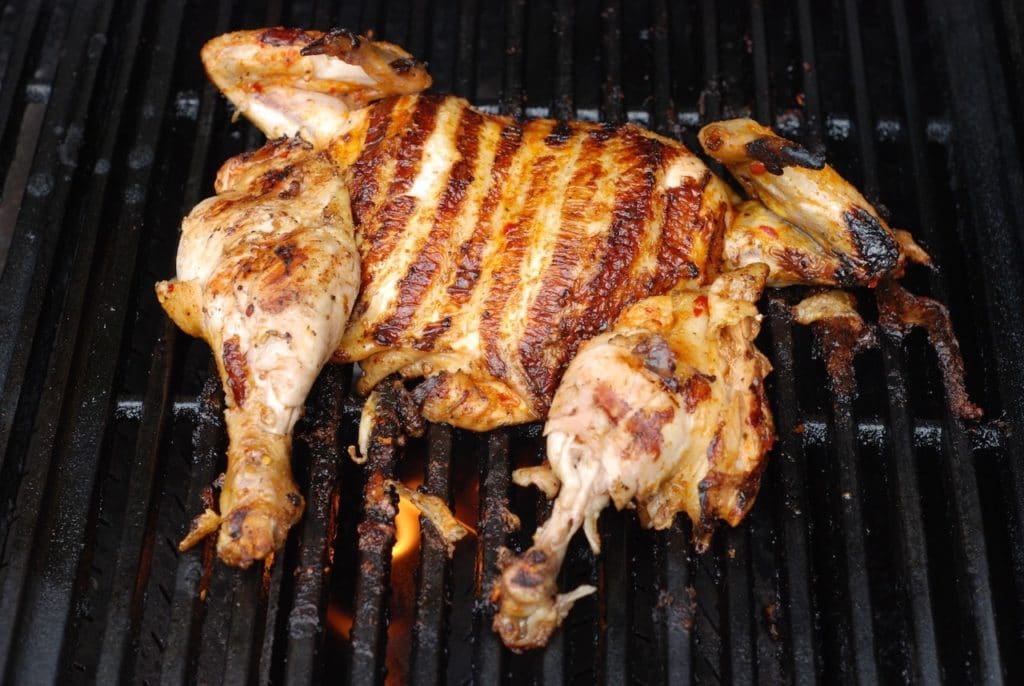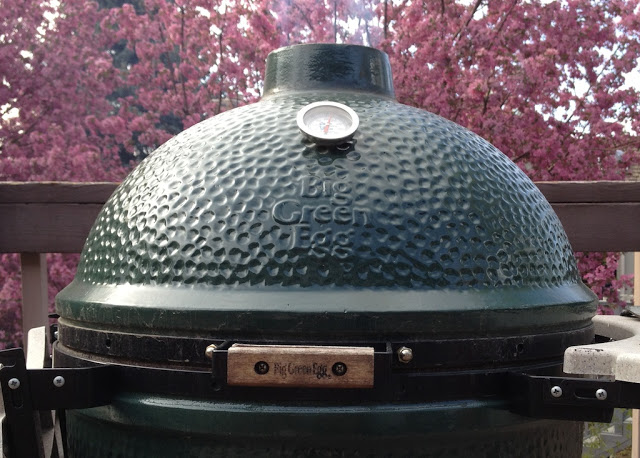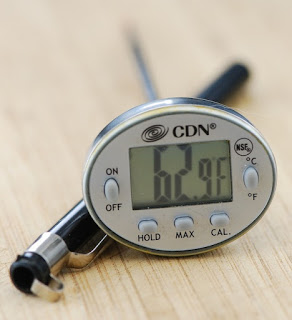(Originally published June 18, 2012. Updated November 19, 2025.)
Grilling chicken should be simple—but anyone who’s cooked enough of it knows the truth: chicken can be downright stubborn. One minute the legs are charred black on the outside and raw in the middle, the next moment the boneless breasts are dry as chalk. But before you blame yourself or your grill, let me offer a little perspective: blame the chicken.
Different cuts of chicken behave very differently over heat because they are built differently. Domestic chickens don’t fly; they walk. That means their leg and thigh muscles are used constantly, which makes them darker, richer, and better suited to long, gentle cooking. Breasts, on the other hand, barely get used, so the meat remains lighter, leaner, and prone to drying out quickly if overcooked.
Understanding these differences—and learning how to adapt your grilling technique to match—is the secret to mastering grilled chicken. Once you know how each cut behaves, grilling becomes fun, predictable, and incredibly delicious.

Quick cooking over high heat produces nicely browned boneless chicken breast that’s moist and juicy.
Boneless Breasts
Boneless chicken breasts are by far the most popular cut of chicken—and the most frequently butchered (figuratively, not literally) on the grill. Because they’re so lean, they cook very quickly, which means there’s a small margin between juicy perfection and sawdust dryness.
An easy trick is to start with very cold breasts. This slows cooking slightly and helps prevent the exterior from browning before the inside has a chance to heat properly. Preheat the grill well and cook over direct medium-high heat, which develops a beautiful sear without burning the delicate meat. Each side usually needs about five minutes, depending on thickness and grill temperature.
Once you pull the breasts from the grill, cover them loosely and rest for five minutes. This allows juices to redistribute, dramatically improving tenderness. If your chicken breasts often turn out dry, try brining, marinating in oil-based blends, or lightly pounding them to even thickness—all reliable ways to achieve the coveted juicy center.
You can also experiment with compound butters or herb pastes spread lightly on top after grilling. These melt into the meat and add richness without overhandling the chicken.
Bone In Breasts
Bone-in chicken breasts cook more slowly than boneless cuts, but in my opinion, they taste better. The bones help moderate heat, protect the meat, and add subtle flavor. Prepare them by seasoning well or marinating beforehand, and begin grilling over direct medium heat, just long enough to brown the skin and create a flavorful crust.
From there, move the pieces to indirect heat to finish cooking gently. This two-stage approach prevents burnt skin and gives you perfectly tender meat. If you’re adding BBQ sauce or a sweet glaze, brush it on only during the final minutes of cooking—sweet ingredients burn quickly but glaze beautifully when applied late.
Another pro tip: place the thickest part of the breast toward the cooler side of the grill. This small adjustment helps everything cook evenly.
Chicken Legs and Thighs
Dark meat lovers rejoice—this is where chicken truly shines. Legs and thighs are naturally flavorful, forgiving, and juicy, but they require a different approach than breasts. Because these muscles work harder during a chicken’s life, they contain more connective tissue, which breaks down slowly and rewards patient cooking.
The biggest challenge with legs and thighs is the tendency for the skin to burn before the inside reaches temperature. The solution? Use a dual-zone fire. Start with medium heat to brown and crisp the skin, turning attentively, then move the pieces to a lower or indirect heat zone and close the lid. This slow-finish method melts collagen, keeps the meat tender, and prevents scorch marks.
As you near doneness, brush with BBQ sauce, spicy honey, or any glaze you love. The sugars will caramelize gently, creating that irresistible sticky-sweet finish. If the skin is on, be extra watchful—dripping fat can flare up fast.
Alternatively, legs and thighs can be cooked low and slow the entire time. The key is vigilance and patience—you’re coaxing tenderness, not rushing it.

Whole birds are great flattened or spatchcocked – Tony’s Flat Chicken pictured.
Whole Chickens
Nothing beats the satisfaction of grilling a whole bird, whether spatchcocked flat or roasted upright. For classic rotisserie-style results, use a drip pan and indirect heat. Bank the coals around the edges of the grill or use one lit side on a gas grill. Place a drip pan filled with water beneath the bird, replace the grate, and roast with the lid closed.
This method ensures gentle, even heat and prevents flare-ups caused by dripping fat. Rotate the bird occasionally for uniform browning. If you’re feeling adventurous, try beer can chicken, which keeps the interior moist and creates beautifully crisp skin.
Personally, I love spatchcocked chicken—removing the backbone and flattening the bird allows more surface area to brown. Season generously, marinate if you like, and cook it just as you would thighs: a quick sear followed by gentle indirect heat. Your butcher at Tony’s will gladly prepare a flat chicken for you at no additional cost.
Seasoning, Marinating and Brining
Great chicken starts with great flavor. At Tony’s, we offer a variety of seasoning blends and marinades that pair beautifully with chicken. When working with sweet seasonings, remember that sugar browns—and burns—quickly. Use indirect heat to avoid scorching, or add sweet sauces only during the last part of cooking.
Brining is a game changer for lean meats like chicken breasts. A good brine improves juiciness, enhances seasoning from the inside out, and gives you a more forgiving cooking window. Most chicken pieces benefit from 3–4 hours in brine. Our brine mixes make the process easy—dissolve, chill, soak, grill, enjoy.

The Big Green Egg adds the perfect flavor to any grilled dish!
Big Green Eggs
“Eggheads” know their beloved grills are great for cooking chicken! The coals are much farther away from the cooking surface, reducing flare up and accidental burning. The Big Green Egg used with hardwood coals and/or wood chips also adds great smoky flavor. If you are crazy about grilling, and if you like fancy grilling tools (and who doesn’t!), I strongly recommend adding a Big Green Egg to your cooking arsenal!
 When is it Done?
When is it Done?
This topic can get a little dodgy. The short answer comes from the USDA, and suggests cooking chicken to at least 165°. The problem is that chicken legs can still be a little tough and bloody in the joints at 165°, and chicken breasts tend to be dried out and chewy at this temperature.For the most tender chicken legs that won’t have any red blood left in the joints, I cook to about 175° internal and then rest, covered for at least five minutes.Chicken breasts are dramatically leaner, I cook mine to 145-150° internal so they turn out moist and juicy. I do this because salmonella is killed at 130° and the surface (where most bacteria lie) gets much, much hotter than this. Most chefs agree, however, officially the recommended temperature is 165° internal! Your are now on your way to mastering grilled chicken breast!
Additional Recipes:
Grilled Chicken Breast With Corn And Tomato Salsa
Grilled Chicken for a Crowd
Shredded BBQ Chicken Biscuit Sliders
Grilled Chicken and Greek Salad
Classic Southern-style BBQ Chicken
Orange Grill Roasted Chicken
Comments are closed.

